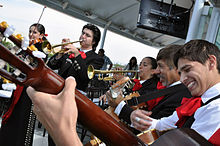Mariachi
| Mariachi | |
|---|---|
 |
|
| Stylistic origins | Son jaliscience, son planeco, sonecitos del país, canción rural |
| Cultural origins | 18th century, Michoacán, Colima, Jalisco |
| Typical instruments | Violin, guitarrón, guitarra de golpe, vihuela, guitar, trumpet, and occasionally a harp harmonica and accordion |
| Subgenres | |
| Ranchera, Traditional | |
| Regional scenes | |
| Mexico, Colombia, Costa Rica, Argentina, Ecuador, El Salvador, Chile, Guatemala, Croatia, Peru, Spain, United States, Venezuela | |
| Other topics | |
| Charro – Jarabe tapatío (also the name of a song) | |
Mariachi (/mɑːriˈɑːtʃi/; Spanish: [maˈɾjatʃi]) is a musical expression that dates back to at least 18th century Western Mexico. It is a tradition that can be defined by eight socio-musical elements: mariachi instrumentation and texture, musical genres and subgenres, performance methods and styles, singing styles and forms, dance styles, performative space, performance clothing, and the word "mariachi". Each element has its own history, originated at varying moments in time and in different regions of the Western Mexican countryside, and some, if not all, had to converge in order for the mariachi tradition to become what it is.
From the 19th to 20th century, migrations from rural areas into cities such as Guadalajara and Mexico City, along with the Mexican government's cultural promotion gradually re-labeled it as Son style, with its alternative name of “mariachi” becoming used for the “urban” form. Modifications of the music include influences from other music such as polkas and waltzes, the addition of trumpets and the use of charro outfits by mariachi musicians. The musical style began to take on national prominence in the first half of the 20th century, with its promotion at presidential inaugurations and on the radio in the 1920s.
In 2011 UNESCO recognized mariachi as an Intangible Cultural Heritage, joining six others of this list from Mexico.
The origin of the word is disputed, but prominent theories attribute it to indigenous roots. One states that it comes from the name of the wood used to make the dance platform. Another states that mariachi comes from the indigenous name of a tree called pilla or cirimo; yet another states that it came from an image locally called María H (pronounced Mari-Ache). In many Mexican cultures they are also called Marietti. Mariachi can refer to the music, the group, or just one musician.
...
Wikipedia
